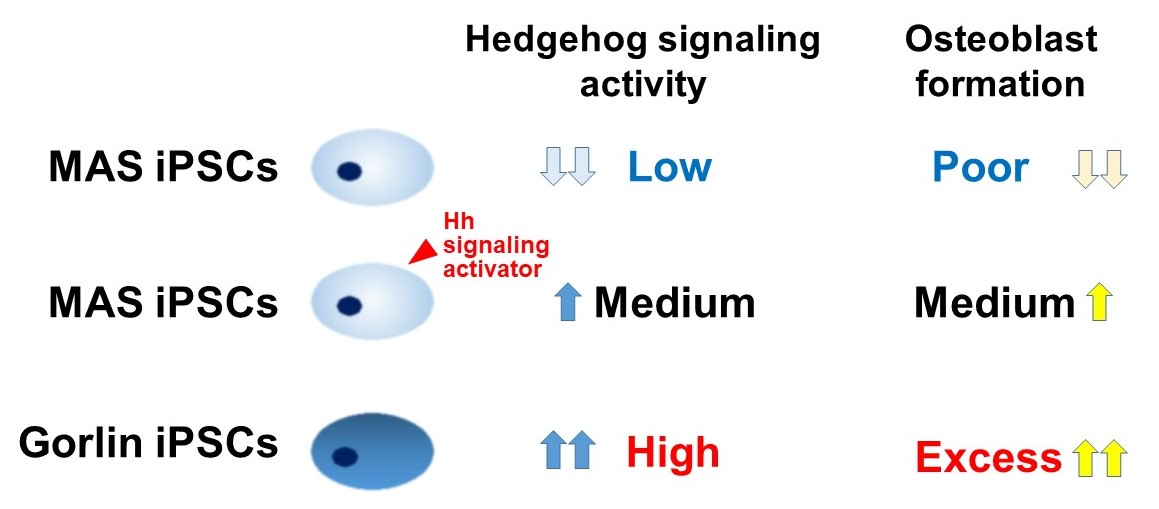June 12, 2020
The action of Hedgehog signaling on human bone formation and molecular mechanisms underlying pathogenesis by its abnormal signaling activities
Prof. Shinsuke Ohba (Department of Cell Biology, Institute of Biomedical Sciences) and his colleagues have identified the action of Hedgehog (Hh) signaling in human bone formation and molecular mechanisms underlying pathogenesis caused by abnormal activities of the signaling in a collaborative project using disease-specific iPS cells (iPSCs) with Profs. Shoko Onodera and Toshifumi Azuma at Tokyo Dental College and Prof. Ung-il Chung at The University of Tokyo.
In the aging society, maintenance of healthy bones and motor function is required for extension of healthy life expectancy. Bones are maintained by the bone remodeling process, in which “bone-forming” osteoblasts and “bone-resorbing” osteoclasts are coordinated well. Disruption of balance between bone formation and resorption leads to various diseases such as osteoporosis. Prof. Ohba’s group has studied mechanisms underlying development and maintenance of osteoblasts. In a series of studies using gene-manipulated mice and stem cell culture systems, they previously demonstrated requirement of Hh signaling for normal formation and maintenance of osteoblasts. However, it remained to be investigated whether Hh signaling was involved in human bone formation, especially in osteoblast formation.
In this collaborative study, they focused on two Hh-related genetic diseases, Gorlin syndrome and McCune-Albright syndrome (MAS). Given that two diseases showed opposite phenotypes in terms of Hh signaling activities and bone formation, they took advantage of disease-specific iPSC models to understand roles of Hh signaling in human osteoblast formation.
Patients with Gorlin syndrome are known to show accelerated bone formation with ectopic activation of Hh signaling because of the mutation of PTCH1 gene. Gorlin syndrome-derived iPSCs (Gorlin iPSCs) showed an increase in osteoblast formation with Hh signaling activation and upregulation of a set of transcription factors in an osteogenic culture, compared to the control iPSCs. Treatment with a Hh signaling inhibitor cancelled the increase in Gorlin iPSCs.
MAS is often characterized with fibrous dysplasia (FD) of immature bones accompanied with aberrant activation of osteogenic Wnt signaling and low Hh signaling activity. MAS-specific iPSCs showed poor osteoblast formation with low Hh signaling activity. Furthermore, impaired osteoblastogenesis was restored to the normal level by treatment with an Hh signaling-activating small molecule.
Thus, these results suggest that Hh signaling has positive impacts on human osteoblast formation. This study may pave a path to new drug therapies for genetic abnormalities in calcification caused by dysregulation of Hh signaling.
This study has been published in Stem Cell Reports, an official journal of International Society for Stem Cell Research (ISSCR), on June 11, 2020.
Shoko Onodera, Akiko Saito, Hironori Hojo, Takashi Nakamura, Denise Zujur, Katsuhito Watanabe, Nana Morita, Daigo Hasegawa, Hideki Masaki, Hiromitsu Nakauchi, Takeshi Nomura, Takahiko Shibahara, Akira Yamaguchi, Ung-il Chung, Toshifumi Azuma, Shinsuke Ohba:
Hedgehog activation regulates human osteoblastogenesis.
Stem Cell Reports (2020)
https://doi.org/10.1016/j.stemcr.2020.05.008
 |
| Analyses of Gorlin iPSCs and MAS iPSCs unraveled the association between Hh signaling activities and human osteoblast formation |
Contact information
Shinsuke Ohba, D.D.S., Ph.D.
Professor
Department of Cell Biology, Institute of Biomedical Sciences
Nagasaki University
Phone: +81-95-819-7630
E-mail: s-ohba*nagasaki-u.ac.jp (change * to @)
Toshifumi Azuma, M.D., Ph.D.
Professor
Department of Biochemistry,
Tokyo Dental College
Phone: +81-3-6380-9260
E-mail: tazuma*tdc.ac.jp (change * to @)










